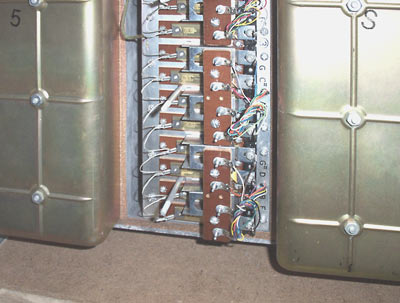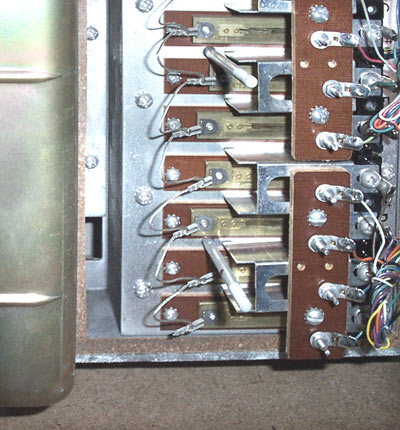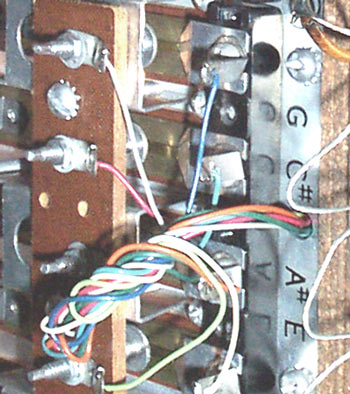Wurlitzer 4600 series
North Suburban Hammond Organ Service
Here we see several pictures of some of the reeds and their associated pickups. In these pans, which are the most easily accessible, the reeds have one or two pickups. The one pickup reeds are used for the lowest bass or sub octave [low CCC or 16' C] and also the very highest octave. The three pickup reeds are used for the first and second octaves of reeds beginning at the note CC or in pipe organ parlance, 8' C.

Figure 8. Reed pans in place. They provide protection from dust and dirt as well as electromagnetic shielding and also contain the air from the high pressure side of the centrifugal blower.
The equipment density within the reed pans is quite high as figure eight shows. The next picture shows this in more detail.

Figure 9. Interior of a pan with reeds having two pickups. The signal commonng wire is plainly visible here and also the terminal strips for the pickups over the front ends of the reeds and the all-important emf shielding pieces over each reed.
In figure nine we have a better look. You can see the individual brass reeds mounted on their shallots which are in turn mounted on Bakelite strips so that they are insulated from the reed unit structure. You can also see the commoning wire that connects all the shallots and ultimately takes the combined signals to the load resistor and then the input stage of the amplifier.
Note the sheet metal shields that isolate the pickups from adjacent reeds to prevent the picking up of signals from nearby reeds. Voltages are high, resistances are very high and signal levels are very low, all of which are conducive to sensitivity and pickup of stray signals from not only adjacent reeds but 60 Hz AC power and also radio frequency signals. The main function of the steel pans, besides protecting and sealing the reed unit is for electromagnetic interference shielding to keep out AC power hum and RF interference from being picked up and creating extra noises in the speakers.
Notice also the adjustable blast gate. Figure nine, the small rectangular opening near the left center of the picture. Here the air from the high pressure side of the system is admitted to the interior of the pan. The air then passes inward through the reeds to make them vibrate.

Figure 10. Closeup of the front ends of the reeds showing the irregular pentagon-shaped front edge pickups and their associated wiring.
Because the reeds vibrate all the time when the instrument is powered on, if they vibrated at a high amplitude, they could ultimately develop metal fatigue and break. The blast gates serve to cut down the air flow to just what is needed to get the reeds going and keep them vibrating. Because these reeds are not used as sources of acoustic sound, they do not have to work hard like the reeds of accordions and reed organs. The blast gates are set to limit the airflow to just enough to keep the reeds moving. Each pan feed channel is fitted with a blast gate.
Figure ten shows the arrangement in still more detail. Here you can see part of the pickups that are over the reeds, and also the sheet metal pickups at the front edges of the reeds. Notice also that the reeds are not in exact order of pitch but are arranged in pitch intervals that are not closely related. This prevents adjacent reeds from pulling into synchronism or interfering with each other's vibration rates. As is evident from these pictures, the electrostatic reed system is a mechanically very complex device and also a very close-tolerance unit. It is probably because of the great expense required to produce it that Wurlitzer discontinued this system in 1961 and all of their subsequent electronic organs used conventional solid state systems similar to those found in many other electronic organs of that era. Needless to say, this also eliminated the unique tonal effects that these instruments produced. Just as with traditional tone wheel Hammonds, I am glad that there are still representative examples of these instruments in existence. (However there are many more Hammonds; it is difficult today to find Wurlitzer electrostatic instruments from the 1950s.) These instruments represent a significant niche in the whole electronic musical instrument domain. When it is working correctly, the electrostatic system gives very good results, stays in tune indefinitely, and is a marvel of mechanical workmanship.
Previous Page Page 8. Next page